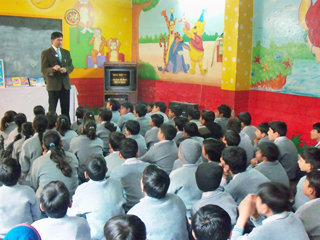New Translations Help Hindi-Speaking Students Understand Their Human Rights

Youth for Human Rights India staff member, G.K. “Karthi” Karthigaikhumara talked to 60 students at a senior secondary school in New Delhi, January 25th, opening their eyes to the realm of “human rights”—a new concept to the students—and what it has to do with their lives.
Karthigaikhumara says he presented the subject in Hindi and English to ensure the students understood human rights.
Karthigaikhumara showed the students the Youth for Human Rights International award-winning videos depicting each of the 30 articles of the Universal Declaration of Human Rights, followed by an interactive question and answer session. “There were quite a number of brilliant students, very enthusiastic,” says Karthigaikhumara who sees great promise in the next generation as a result of the Youth for Human Rights program. He also gave each student pamphlets containing an abridged version in Hindi of the Universal Declaration of Human Rights. Translated and produced by the YHRI Chapter in India, the pamphlets have been acknowledged by several Indian professors as key to opening the door to human rights education.
“The same conditions that make India a richly diverse nation also contribute to the human rights issues we face,” says Karthigaikhumara. “With 14 official languages, every major religion on Earth and hundreds of ethnic and political beliefs, conflicts are to be expected in this mega-democracy.”
Karthigaikhumara says Youth for Human Rights International, with its purpose to teach youth about human rights and inspire them to become advocates for tolerance and peace, is a strong tool for progress. “We are here not to protest about human rights violations,” says Karthi. “We are here to bring awareness and education at a grass-roots level.” Towards that end, YHRI members are currently spearheading translations of abridged versions of the United Nations Universal Declaration of Human Rights in several more languages.
